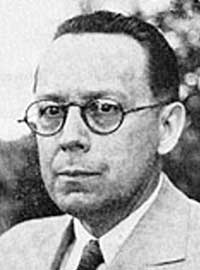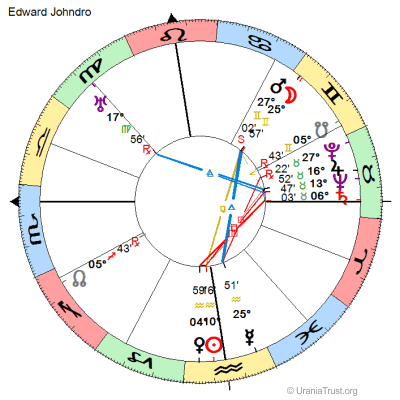 Lorn Edward Johndro
Lorn Edward Johndro30 January 1882, 12:30 AM
Franklin Center, Que., Canada
Placidus Houses, True Node
Geocentric, Tropical
(Source Notes)

Edward Johndro was one of the great astrologers of the last century. I have found that it is more important to understand his concept of astrology then it is too determine his specific techniques. This outlook can then be applied to astrological work in general. We can learn much about his character and his ideas from the eulogy, from which I shall be quoting, that was begun by his associate, Kenneth W. Brown. During this task, Brown passed away, leaving the completion to Charles Jayne.
Much of my knowledge of his work was through my 12-year association with Charles A. Jayne, Jr. Many of his concepts were based upon Johndro's ideas. Brown once said: "This discovery, made by Jayne, was only possible because of Johndro's work."
The Man
Lorne Edward Johndro was born on January 31, 1882 on the same day as President Roosevelt. He commenced his study of astrology in July of 1903, the same month during which his future partner W. Kenneth Brown was born. He then moved to the west coast where he resided until his death in November of 1951, his wife dying within one-half hour of him. (It was the same month and year of the death of Elbert Benjamine, founder of the Church of Light.)
Johndro was a mathematician, physicist, and radio engineer. Indeed, he taught the first two subjects professionally. This honed his scientific approach to astrology. He was an original thinker who discovered new concepts that tradition-bound astrologers were unwilling to accept. If his new discoveries did not stand up under rigorous testing, he abandoned the idea. It may surprise some readers that Johndro eventually abandoned his mundane idea of the moving baseline method of correlating the earth with the heavens. In a letter to Jayne prior to his death, he dropped the baseline idea in favor of the more traditional and simple relocated horoscope.
He published two books in 1929: The Earth in the Heavens and The Stars: How and Where They Influence. He then authored two bulletins in the early 1930s: A New Conception of Sign Rulership and Astrological Dictionary. Somewhere in between he issued a pamphlet about WW1, which was a study in locational astrology.
He met Ken Brown in 1935 beginning a 15-year partnership that began in the next year. They advised businessmen with Brown the contact man and Johndro the rectifier of charts and the calculator. In this entire time, the two never met face-to-face. Jayne told me that the pair did all of the stock market work for W.D. Gann. This might explain why Gann's planetary work was sophisticated. Brown wrote that Johndro had developed a successful system for forecasting commodities based upon eclipses.
The Precision Astrologer
Both Johndro and Jayne had the same view of predictive work. They both believed that there was a very precise planetary configuration that described every event. I think that both would agree that it was possible to predict minor events on a day-day basis. They were opposed to the thought that an event was caused by last week's Saturn hit or next week's Uranus transit. They disapproved of this thought that the former's influence lagged while the latter's led. Both were masters of rectification. Jayne said that if one could successfully rectify 50 charts, one would become an excellent astrologer.
The Vertex
Jayne and Johndro corresponded by mail, but never met. Jayne received a letter from Johndro explaining his work with the newly-developed electrical ascendant. Jayne tested this new point by running solar arcs to it. He concluded that the opposite point in the zodiac was more sensitive. Johndro followed this conclusion with more testing and found Jayne's finding to be accurate. Today, we know this point as the vertex. They agreed that this point was fated and represented matters beyond our control.
The discovery of the vertex was based upon his GEM dynamic field theory where G stands for gravity, E for electrical, and M for magnetism. The meridian and the midheaven correlated to gravity, the electrical ascendant (antivertex-vertex axis) to electricity, and the ascendant and horizon to magnetism.
The 24th Harmonic
Johndro read a chart in multiples of 15 degrees, a division of space by 24 instead of 12. He utilized the Campanus house system in the conventional 12-house and in his new 24 half-house system. It is curious to note that I have found this harmonic to be important at stock market turning points. Johndro worked for Gann, and perhaps that is where he discovered their significance. Johndro considered the 15, 75, 105, and 165-degree openings to be aspects. He felt that planets must be connected by some 15-degree multiple in order to be considered to be in contact.
I met John Addey about 35 years ago. He gave me a list of the basic meanings of each harmonic, 1 through 9. I asked him how one could determine the flavor of the 24th harmonic. He said that the meaning could be derived by taking the interpretations of the numbers that had a product equaling 24. So by combining 3 and 8 or 4 and 6, we could find the 24th harmonic. In both cases, we thought that one number represented stasis, no change, status quo. The other represented sudden and free movement. It made us both think of Saturn-Uranus. So we concluded that the 24th harmonic ruled change of trend, to move from one state to another.
The Fixed Stars
Johndro's background as a radio engineer led him to describe the power of the stars in the following way. He felt that their influence was analogous to high frequency radio waves. The planets had much lower vibratory rates, and served to modulate the energy of the stars. Both he and Jayne felt that the planets acted as step-down transformers for the stars, and that no ordinary person could directly tap into the star power due to its purity and intensity.
Predictive Techniques
Jayne used to say that all techniques work. He did not reject any of them. He felt that each had its value in a particular situation. The astrologer had a toolbox of techniques to dip into to solve any problem. Thus, Jayne and Johndro spent no time promoting one procedure versus another; they chose to test and allow the results to speak for themselves.
Johndro used direct and converse solar arcs. He saw that, due to planetary latitude and the inclination of planetary orbits to the ecliptic, aspects to the same system of directing could repeat many times. So the effect of an aspect by direction could be spread out over a period of time. Therefore, he left a 'time orb'. He allowed a time orb of duration of 6 days for aspects. Because the semidiameter of the Sun was 16 minutes and that of the Moon was 15 minutes, the time orb for directions involving the lights was 3 months. Solar arcs became a prime tool in rectification, especially for directing Uranus to the angles.
To give an example of Johndro's exacting approach, let us look at his view on the calculation of solar arcs. He found that there was a qualitative difference between the solar arc as measured by right ascension and that measured along the ecliptic. The former method created events while the latter controlled the public reaction to events. One could precede the other or they could occur together. For example, the solar arc generated by RA could represent a fire in a theater; the solar arc generated from the ecliptic produced the public's reaction to the fire and a demand for greater safety. If the ecliptic solar arc occurred first, there would be a public demand for greater safety in theaters followed by a fire. Or, the two could become exact at the same time leading to the fire and the public reaction being simultaneous. Note that there is no attempt to discriminate between the two on an "either-or" basis.
Other arc directions were developed by Jayne, but his thinking and approach were influenced by Johndro. He felt that if all techniques were valid, then they must vary as to strength and interpretation. Slow techniques such as secondary progressions were very powerful, but gradual in their effect. They tended to generate conditions. Arc techniques were sharper and more noticeable in effect, but were of shorter duration. These tended to precipitate events. These arc methods were declination, vertex, and ascendant arc. Ascendant arc is calculated by subtracting the natal ascendant from the progressed ascendant. Vertex arc is also computed by deducting the natal from the progressed vertex. Declination arc is the difference between the natal and the progressed Sun in declination.
Eclipses
His work on eclipses was considerable, but most of it was never published. I was able to gain the following insights though by working with Charles Jayne.
The rule of thumb was that a solar eclipse could have an effect for up to 6 to 9 months in advance and perhaps as long as a year afterward. I can safely say that the effect of the eclipse begins to stir in a horoscope 3 months before it occurs. In practice, one was safe assuming that an eclipse had an effect beginning at least 3 months before the phenomena and lasting for 6 months or at least until the next solar eclipse. This latter rule was amended if there were more than one eclipse in a short period of time such as in 1982. In that year, there were eclipses on June 21 and July 20. In this case the effect of the June 21 eclipse would not end on July 21, rather, it would be considered to have an effect for at least 6 months and possibly as long as 12. Lunar eclipses were determined to have an effect for about 6 weeks on either side of the event, a total of 3 months.
The statement that an eclipse can have an influence before it occurs may seem odd to some. Jayne said in 1953:
It has also been discovered that a transit to the place of an eclipse is effective within nine months to a year of the time of an eclipse, and this applies to eclipses occurring later than the planetary transit as well as before it takes place.
As to why this occurs, Edward Johndro wrote in the late 1930's:
Time as we habitually conceive it, chronologically and in sequence, as well as our ordinary 'consciousness rate' by which we apprehend it, arises solely from the orbital and axial revolutions of the earth. Aside from this, the terms day and night and seasons have no meaning. If all men were born and lived at either of the earth's poles, and had access to no knowledge of life at other points on the earth's surface, we would never evolve the concepts of 24-hour cycles of the day and night. And if the human race lived on the Sun it would never evolve the notion of spring, summer, autumn, and winter. We would view all life as an eternal now, and we would view the universe not from the temporal illusions arising from the relative motions in time and space, but as a continuum.
Most of human and world events happen outside our personal lives and world, and out of our ken. We hear or otherwise become aware of them in what to each of us is a 'later' hour, day, or month or year. For each of us, the impersonal or distant event becomes our awareness of it. You would not insist that the event could not precede your awareness of it by weeks or months. It is equally silly to insist that an event cannot precede the eclipse that defines its awareness or shadow pattern.
Events occurring near eclipses are always memorable. They tend to add energy to any activity that takes place near them. These events take on more importance than the same type of event that occurs distant from an eclipse. There is a sharp difference between the week before and the week after the eclipse. Any event or undertaking begun in the week prior to a solar eclipse differs from those actions taken after the eclipse in that they are very fated. That is, it works out unexpectedly. Events before and after the eclipse are more important, but the events occurring before the eclipse take on the added attribute of being unpredictable. It is best to postpone major decisions until the week following an eclipse because one usually obtains new information or awareness that causes one to make a different decision. The eclipse is a red flag indicating that there is hidden knowledge that can upset one's plans.
Affairs begin and end abruptly around eclipses. There is a sudden focus, and then the emphasis terminates as abruptly as it began. Lunar eclipses are less powerful, but they have the same character. Eclipses can mark changes in phase in one's life. These events may be initiations or terminations. There can be sharp and dramatic changes in one's status and prestige. Public standing may soar or crash due to the effects of an eclipse.
Way Ahead of His Time
L. Edward Johndro was one of the great technical astrologers. Unfortunately, much of his work was not published. The reason is found in this quote by Charles Jayne:
Johndro, who died an embittered man because his contemporaries paid comparatively little attention to his life work and new ideas, was a brilliant man who was ahead of his time. It is probable that as the ideas of many of his contemporaries wane in influence in time, the impact of his revolutionary ideas will wax in influence. If such is the case, this will not be the first time that a man's star has shown forth after his death.
Bill Meridian

Bill Meridian is a financial astrologer. He began to study astrology in 1972 as he entered Wall Street after he received his MBA at NYU. He trained as a bioenergetic therapist with Dr. John Pierrakos in New York City for 7 years. Bill began applying computers to financial astrology in 1983 eventually designing the AstroAnalyst. He has written several books, including Planetary Stock Trading, which uses company first trade dates to pick winners.
